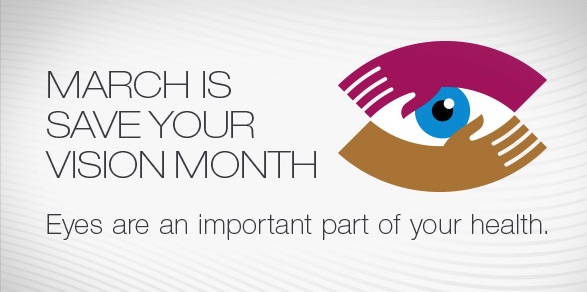 Save Your Vision Month was started 78 years ago to remind people of the need for regular comprehensive eye examinations to increase eye health and overall wellbeing. With Save Your Vision Month coming to a close, we wanted to provide you with a few additional tips that will help you have better vision in 2017. Eye care is a lifelong task that begins in infancy. Children can receive an eye examination as soon as 6 months of age. Just be sure to find a specialist that treats young children. Children and adults should receive annual eye examinations to ensure the health of your eyes and correct prescriptions, and to catch early signs of eye disease.
Save Your Vision Month was started 78 years ago to remind people of the need for regular comprehensive eye examinations to increase eye health and overall wellbeing. With Save Your Vision Month coming to a close, we wanted to provide you with a few additional tips that will help you have better vision in 2017. Eye care is a lifelong task that begins in infancy. Children can receive an eye examination as soon as 6 months of age. Just be sure to find a specialist that treats young children. Children and adults should receive annual eye examinations to ensure the health of your eyes and correct prescriptions, and to catch early signs of eye disease.
There are daily activities you can participate in to ensure your eyes are healthy for today and remain healthy in the future.
Eat for eye health. Certain foods provide nutrition that help prevent eye diseases and vision loss as you age. Some of those foods are leafy greens, especially kale and spinach. The catch: Leafy greens, like spinach and kale, are a source of powerful antioxidants that help prevent eye damage from sunlight, smoke, and air pollution. Other greens with similar benefits include: collard greens, broccoli, and kiwi. Vitamin C is also high in antioxidants and beneficial for your eye health. While Vitamin C can be taken as a supplement, it is best absorbed through food. Some foods that are high in Vitamin C include grapefruit, strawberries, Brussel sprouts, papaya, oranges, and green peppers.
Wear sunglasses. Sunglasses that block 99%-100% of UVA and UVB light rays can help reduce your chances of cataracts and age-related macular degeneration. Cataracts are the most common cause of vision loss in adults over 40, affecting just under 1 million adults in the State of Ohio. Age-related Macular Degeneration is the most common cause of vision loss in older Americans, affecting over 85,000 older adults in Ohio. Something as simple as wearing sunglasses can go a long way in making sure your vision is as clear as it can be for days and years to come.
Give your eyes a break. American adults now spend over 11 hours per day using electronic media – viewing the screens of their televisions, cell phones, and tablets. Cell phones are often the first thing in the morning and last thing in the evening that most adults see and check up to 74 times per day, depending on their age group. With a continual increase in screen time growing, it’s important to know what’s at stake. Digital eye strain is a real condition that can cause physical discomfort. Staring at screens can also cause blurry vision, dry eyes, and headaches, among other things. But there is good news. There are ways you can help your eyes, given a high use of technology. First, be sure to have regular eye examinations. If you need a prescription, you want to ensure it is up-to-date for maximum visual ability and comfort. When viewing a screen, sit so your eyes are level with the top of the monitor. This will allow you to look down onto the screen, lessening the chances of neck pain, back pain and headaches. Be sure to blink regularly to keep from getting dry eyes. And take breaks: rest your eyes every 20 minutes and look 20 feet away for 20 seconds.
So take a moment to think of the ways you can do your eyes a favor – make a favorite meal with some leafy greens or take a break from your TV to enjoy a new book or an afternoon walk outside, sans cell phone, preferably while wearing sunglasses.



